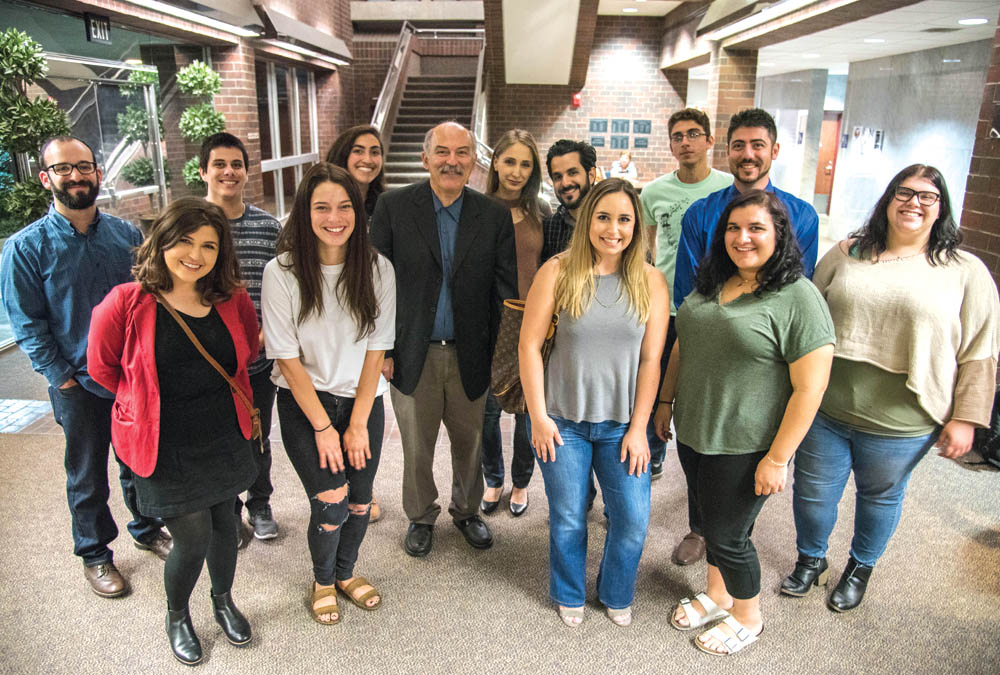
Photo: Hourig Attarian
Claire Kasaian
Staff Writer
Professors Barlow Der Mugrdechian and Professor Hagop Ohanessian and students who participated in the Armenia Study Abroad Trip 2017, May 24-June 9, shared their reflections at a community lecture on Tuesday, October 24. Professor Der Mugrdechian introduced the students and thanked the Leon S. Peters Foundation and the Continuing Global Education Division at Fresno State for providing students with financial support to give students the opportunity to go on this trip. Prof. Der Mugrdechian has led eight study-abroad trips to Armenia, beginning in 1988, with a total of 82 student participants.
Prof. Der Mugrdechian began the presentation with a PowerPoint that included maps and photos from various regions of Armenia that the students visited. Dilijan, Haghartsin, the monastery of Geghard, the Temple of Garni, Holy Etchmiadzin, Lake Sevan, Gyumri, and the monastery of Tatev were among the major sites visited.
Student participants of the trip in the audience laughed as they recalled memories associated with each photo. Prof. Der Mugrdechian planned major day-trips around significant monasteries, which were not only interesting end-destinations themselves, but provided a reason to see the diverse regions of Armenia. Prof. Der Mugrdechian noted that many of the places students visited had long and intricate histories.
Prof. Der Mugrdechian explained that Yerevan celebrated its 2,799th anniversary in 2017. Students were able to visit the ancient Urartian fortress of Erebuni, which is considered the original site of the future Yerevan. “One of the things I wanted to get across to our students was the concept that Armenia is not just a modern place of restaurants and cafés, but a place with a long and important history,” said Prof. Der Mugrdechian.

In addition to day trips, Prof. Der Mugrdechian took students to important sites within Yerevan, such as the Matenadaran (Library of Manuscripts), the Vernissage (outdoor market), museums, and historic sites. Students had some free afternoons and evenings to explore the city of Yerevan. The group stayed at the Ani Plaza Hotel, which because of its location was a convenient central starting point. “I think the students appreciated the fact that you could walk out of the Ani Plaza Hotel and in ten minutes be in the most active parts of the city,” said Prof. Der Mugrdechian.
Professor Hagop Ohanessian then shared his reflections of the trip to Armenia, his first in 10 years. Prof. Ohanessian described the many changes he noticed, such as the changes to the infrastructure. As a Syrian-Armenian himself, Prof. Ohanessian related how grateful he was to be able to meet Syrian-Armenian refugees and learn about their experiences in Armenia. Many of them opened Western Armenian restaurants in Armenia. “Eating at these restaurants reminded me of the traditional foods prepared by my own family,” said Prof. Ohanessian. He was also able to reunite with his mother’s cousin and her family. In conversation with many of these refugees, Prof. Ohanessian noted that many of them remained homesick for Syria.
Prof. Ohanessian shared that the most rewarding part of the trip for him was witnessing the students’ reactions to the country. “They were curious and asked great questions wherever we went. They were able to put into practice all that they had learned in the classroom.”
One of the student participants, Marine Vardanyan, concluded by sharing the students’ point of view of the trip with photos and video. Other students were welcomed to give their reflections on the trip during Vardanyan’s presentation.
One of the students’ most memorable impressions was of their three visits to the Mer Hooys-House of Hope home for disadvantaged girls. Two students, Annie Rubio and Shelbie Ohanesian, related how those visits left a deep impact upon them. They both said that visiting the girls was one of the highlights of the trip. It is not hard to say that the students had a very memorable trip with memories that will last a lifetime.
 Hye Sharzhoom Armenian Action
Hye Sharzhoom Armenian Action